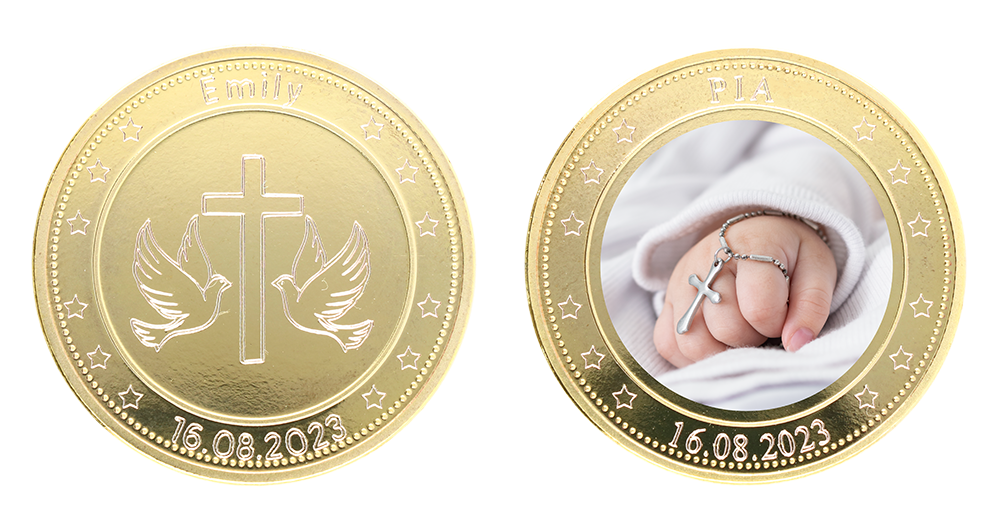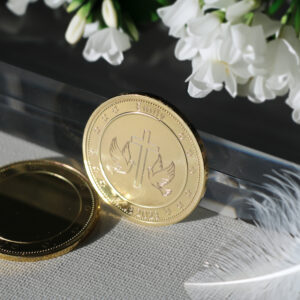Christening and baptism are significant milestones in many religious and cultural traditions. These events celebrate the introduction of a new life into a faith community and are often accompanied by special ceremonies.
One cherished tradition that accompanies these occasions is the gifting of christening or baptism coins. These coins, rich in history and symbolism, serve as lasting keepsakes for the child being baptised.
Table of Contents:
- Baptism and Christening Coins
- A Simple Ordering Process
- Personalising Your Coin Design
- Packaging and Display Solutions
- The Tradition Behind Christening and Baptism Coins
- A Brief History of Christening and Baptism Coins
- Symbolism and Significance
- Types of Christening and Baptism Coins
- Presenting the Coin
- Christening Coins, A Gift of Lifelong Value
- Frequently Asked Questions – Baptism Coins
A Simple Ordering Process
Ordering your custom gold coin from Custom Coins is quick and straightforward:
- Create Your Design: Use our online configurator to craft your design.
- Packaging Selection: Choose your preferred packaging to suit the occasion or recipient and send your order.
- Production: After receving the order, our skilled team will start manufacturing your coins using top-quality materials.
Whether you need a single coin or a large batch, our process accommodates all order sizes and requirements.
Personalising Your Coin Design
We offer a range of options to customise your coin, giving it a personal touch:
- Text Placement: Include personalised text on the top, middle, or bottom of either side of the coin, allowing you to convey your message in the way that suits you best.
- Image or Photo Addition: You can engrave or print a photograph or image directly onto the coin’s surface, adding an extra layer of meaning and detail.
Our online configurator makes it easy to create a mock-up of your coin, so you can see how the final product will look.
This way, you have full control over the design process to ensure the coin meets your expectations.
Packaging and Display Solutions
How your baptism coin is presented can make a significant difference. We offer various packaging options to elevate your coin’s impact:
- Velvet Boxes: Ideal for a luxurious presentation, adding a sense of elegance.
- Wooden Boxes: Perfect for showcasing your coin as a gift or collectible item.
- Frames: Great for displaying on a desk or shelf, turning your coin into a piece of art.
These packaging options add a finishing touch that enhances the value and appeal of your baptism coin.
The Tradition Behind Christening and Baptism Coins
Gifting coins during a christening or baptism has roots in various cultures and religions. Historically, coins have been seen as symbols of prosperity, protection, and good fortune. In the context of a christening or baptism, coins are given as a token of blessing for the child’s future.
They represent a wish for the child to grow up with wealth not just in material terms, but also in happiness, health, and spiritual fulfillment.
In some cultures, the act of giving coins is seen as an investment in the child’s future. It symbolizes the hope that the child will always have enough to meet life’s challenges. The coins can be stored safely and passed down through generations as a cherished family heirloom, carrying with them the love and best wishes of those who gifted them.
A Brief History of Christening and Baptism Coins
The tradition of giving coins dates back to ancient times. In Roman culture, newborns were often given coins as a token of good luck and prosperity.
This practice evolved over centuries and became integrated into Christian baptism ceremonies as a way of offering a tangible blessing.
During the Middle Ages, it was common for nobles to gift coins made of precious metals to symbolize protection and wealth.
In Victorian England, it became fashionable to give a silver coin as a christening gift, a custom that persists to this day. This coin was not necessarily meant for spending but rather as a keepsake to remind the child of their baptism and the wishes for their future.
Symbolism and Significance
Christening and baptism coins are imbued with symbolism. The coin’s material—often silver, gold, or other precious metals—represents purity, value, and the child’s bright potential.
Silver coins are the most traditional and popular choice, symbolizing innocence and hope. In some cultures, the number of coins also carries meaning.
For example, three coins may be given to represent the Holy Trinity in Christian tradition: the Father, the Son, and the Holy Spirit.
The imagery on these coins often includes religious or spiritual symbols such as crosses, angels, or doves, each carrying its own significance.
A cross may signify faith, while a dove represents peace and the presence of the Holy Spirit.
Some coins also bear inscriptions of blessings or prayers, reinforcing their role as tokens of protection and good fortune.
Types of Christening and Baptism Coins
Christening and baptism coins come in a variety of styles and designs, tailored to suit different tastes and cultural traditions. Here are some common types:
- Silver Christening Coins: Silver coins are the most traditional choice for a christening or baptism gift. They are often engraved with religious symbols, names, dates, or even special prayers. Their simplicity and elegance make them a classic keepsake that can be treasured throughout the child’s life.
- Gold Baptism Coins: For a more luxurious option, gold coins are sometimes the best option. Gold is seen as a symbol of prosperity and enduring value. Our coins, in .999 Silver with 24K Gold Plating, are often more elaborate, featuring detailed engravings and ornate designs. These coins may include designs specific to the event, such as the child’s name, baptism date, or images of saints or religious scenes.
- Keepsake Coin Sets: Some families choose to give sets of coins that can be added to on subsequent special occasions. For example, a child may receive a christening coin, followed by coins for their first birthday, first communion, and other significant life events.
Presenting the Coin
The presentation of the coin can be as meaningful as the coin itself. Often, the coins are placed in a decorative box to be given during or after the christening ceremony.
Some original ideas include a handwritten note or a card explaining the symbolism of the coin and the wishes they hold for the child’s future.
Christening Coins, A Gift of Lifelong Value
Christening and baptism coins transcend the material world, offering a connection to faith, family, and heritage. They provide a sense of continuity, reminding the child of the community that welcomed them and the shared beliefs that underpin their upbringing.
As they grow, the coin serves as a tangible link to their past, guiding them through life’s spiritual and personal milestones.
These coins are not merely gifts for a single occasion but lifelong tokens of love, faith, and enduring connection.
In an ever-modernising world, the significance of tangible items like christening and baptism coins remains profound. They offer a counterbalance to the transient nature of digital mementos, embodying timeless values and traditions that will continue to hold meaning long into the future.
Whether given in silver or gold, these coins are far more than material objects; they are vessels of blessing, tradition, and love—bridging the past, present, and future in a child’s life.
Frequently Asked Questions – Baptism Coins
1. What is the purpose of a christening or baptism coin?
- A christening or baptism coin serves as a symbol of blessing and a keepsake for the child’s future. It is given to wish the child prosperity, health, and spiritual well-being. These coins also act as a tangible reminder of the child’s introduction into their faith community.
2. Is there a specific type of coin that is traditionally given for a christening or baptism?
- The most traditional coins for christenings are silver coins due to their symbolism of purity and innocence. Gold plated coins are also popular for their association with wealth and enduring value. However, modern options include custom-engraved or commemorative coins featuring religious symbols or inscriptions.
3. Do christening or baptism coins have religious significance?
- Yes, christening and baptism coins often carry religious significance. They may be engraved with symbols like crosses, doves, or angels that represent aspects of faith. The coin itself symbolizes blessings, protection, and the hope that the child will be spiritually prosperous throughout their life.
4. Can I personalise a christening or baptism coin?
- Absolutely! Many people choose to personalise these coins with the child’s name, initials, baptism date, or a special message. Custom engraving adds a personal touch, making the coin a unique keepsake that reflects the child’s individual journey and the giver’s best wishes.
5. How should I present the coin during a christening or baptism ceremony?
- The coin is often placed in a decorative box or a frame that can be presented to the child’s family during or after the ceremony. Including a handwritten note or card explaining the symbolism of the coin and your wishes for the child adds a meaningful touch.
6. Is it appropriate to give a coin as a christening or baptism gift in all cultures?
- While the tradition of giving coins is most common in Christian cultures, the practice of giving symbolic gifts for a child’s blessing exists in many cultures and religions. It’s a good idea to consider the family’s cultural and religious background before choosing this gift, as they may have specific customs or preferences.
7. What is the significance of silver coins in christening and baptism ceremonies?
- Silver coins are traditionally associated with purity, innocence, and hope. They have been used in christening ceremonies for centuries, particularly in Victorian England. Silver is seen as a precious metal that symbolizes the bright potential and spiritual wealth of the child.
8. Can the child use the coin as they grow older, or is it purely symbolic?
- Christening and baptism coins are generally meant to be keepsakes rather than for everyday use. They serve as a memento of the child’s baptism and are often passed down through generations as family heirlooms. However, some families may view the coin as an investment for the child’s future, particularly if it’s made of precious metal.
9. What types of designs are common on christening and baptism coins?
- Common designs include religious symbols such as crosses, doves, angels, and images of saints. Some coins may also feature inscriptions, prayers, or blessings. Personalised coins may include the child’s name, baptism date, or a unique message to commemorate the occasion.



